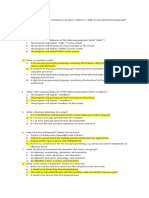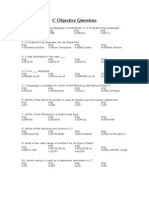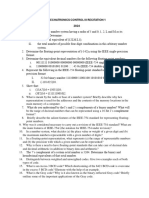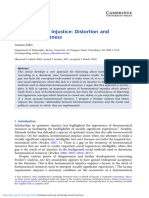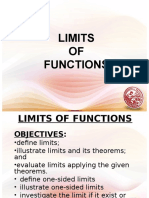Worksheet 1.2: More Challenging Questions: © Cambridge University Press 2016
Worksheet 1.2: More Challenging Questions: © Cambridge University Press 2016
Uploaded by
ezzeddinezahra_55049Copyright:
Available Formats
Worksheet 1.2: More Challenging Questions: © Cambridge University Press 2016
Worksheet 1.2: More Challenging Questions: © Cambridge University Press 2016
Uploaded by
ezzeddinezahra_55049Original Title
Copyright
Available Formats
Share this document
Did you find this document useful?
Is this content inappropriate?
Copyright:
Available Formats
Worksheet 1.2: More Challenging Questions: © Cambridge University Press 2016
Worksheet 1.2: More Challenging Questions: © Cambridge University Press 2016
Uploaded by
ezzeddinezahra_55049Copyright:
Available Formats
Worksheet 1.
2: more challenging questions
1 Binary coded decimal (BCD) can be used to store currency values with each
individual denary digit represented by one BCD code and an implied position for
the decimal point. It is possible to carry out arithmetic using BCD but this
requires a special technique as discussed in the coursebook.
a Use the following diagram to show the BCD representations of the two
numbers 9.75 and 7.68 assuming packed BCD is used.
b If the two numbers are added what is the total expressed as a denary
value?
c If the two binary representations are added ignoring the fact that they are
BCD codes what is the result obtained?
d Show a correct calculation using the BCD values but applying the correction
factor 0110.
e Why does this correction factor work?
f 9.75 can be represented exactly as a fixed-point binary value but 7.68
cannot. Why is this so?
2 The following table is a rearranged version of Table 1.04 in the coursebook. It
shows a possible set of Huffman codes to be used for lossless compression of a
text consisting only of the eight letters shown.
e t o h l p w z
10 01 111 110 0001 0000 0011 0010
The codes will have been chosen by using an algorithm that has as input the
frequencies of occurrence of each of the letters in the particular text. The choice
of codes can be represented as a Huffman tree. A partially completed tree is
shown below:
e t
p THIS NEEDS DRAWING
<Figure 1.02 z PROPERLY> b
© Cambridge University Press 2016
a Can you work out the rules that are being used to position the letters on the
tree so that they have the codes as shown in the table?
b Can you complete the tree by placing the remaining letters?
c Could this tree be extended to include more letters? If not why not?
d Can you suggest a modification of the tree to include two more letters?
© Cambridge University Press 2016
You might also like
- MR Logbo - Grade 11 AP CSP 2nd MP Exam 22 - 23Document4 pagesMR Logbo - Grade 11 AP CSP 2nd MP Exam 22 - 23Joel LogboNo ratings yet
- Gcse Computer Science 8520/2: Paper 2Document20 pagesGcse Computer Science 8520/2: Paper 2karuneshnNo ratings yet
- Logic Design and Digital CircuitsDocument3 pagesLogic Design and Digital CircuitsShawn Michael SalazarNo ratings yet
- 2 Marks With Answer DLCDocument53 pages2 Marks With Answer DLCCentral Placement Cell - RVSCET, CoimbatoreNo ratings yet
- CSE 20 Discrete Math: Winter 2020Document14 pagesCSE 20 Discrete Math: Winter 2020Edgar FloresNo ratings yet
- Assignment 2: Binary Number SystemDocument1 pageAssignment 2: Binary Number SystemayaNo ratings yet
- CA Week 3 - TutorialDocument2 pagesCA Week 3 - Tutorialalexanderlouis.auNo ratings yet
- Lesson 5Document10 pagesLesson 5sherrylNo ratings yet
- Assignment1 July2024Document4 pagesAssignment1 July2024Sudharsanan RadhakrishnanNo ratings yet
- Cos 118 TQ PDFDocument8 pagesCos 118 TQ PDFemmanuelfisayo94No ratings yet
- ôn tập CSIDocument52 pagesôn tập CSIdunghshe186237No ratings yet
- ExerciseDocument2 pagesExercisedagNo ratings yet
- The Number SystemDocument39 pagesThe Number SystemRomel SarmientoNo ratings yet
- Chapter 1 As Level Computer ScienceDocument4 pagesChapter 1 As Level Computer Sciencesuryakarthikeyan248No ratings yet
- Python Modules Summary TestDocument26 pagesPython Modules Summary TestArn ArnNo ratings yet
- Aqa 85201 ExDocument28 pagesAqa 85201 ExvagheliszNo ratings yet
- 2.1 Brief History of C: Overview To C LanguageDocument10 pages2.1 Brief History of C: Overview To C LanguageAnonymous eur0QxuBCmNo ratings yet
- Digital ElectronicsDocument58 pagesDigital ElectronicsLara Mae M. BangugNo ratings yet
- C Programming NotesDocument17 pagesC Programming Notesanshukiran.s30No ratings yet
- Tutorial #1 PDFDocument3 pagesTutorial #1 PDFHilal HuseyinliNo ratings yet
- Vac DataRepresentationDocument1 pageVac DataRepresentationMunyaradziNo ratings yet
- C Objective QuestionsDocument2 pagesC Objective Questionsapi-19933407No ratings yet
- Huffman_codingDocument30 pagesHuffman_codingastroboii999scribdNo ratings yet
- CAIE AS Level Computer Science 9618 Theory v1 Z-NotesDocument20 pagesCAIE AS Level Computer Science 9618 Theory v1 Z-NotesAnar NyambayarNo ratings yet
- SpreadsheetDocument14 pagesSpreadsheetbill100% (1)
- Solution Manual For Succeeding in Business With Microsoft Excel 2013 A Problem Solving Approach 1st EditionDocument3 pagesSolution Manual For Succeeding in Business With Microsoft Excel 2013 A Problem Solving Approach 1st EditionHelene Tefera100% (45)
- AS Level CS P1Document20 pagesAS Level CS P1Danial KashifNo ratings yet
- Dsa Q31Document3 pagesDsa Q31sanskritiNo ratings yet
- ch3 Part1Document7 pagesch3 Part1hassan IQNo ratings yet
- ICT Final Exam For Grade 9Document4 pagesICT Final Exam For Grade 9YibeltalNo ratings yet
- Cs NotesDocument19 pagesCs NotesBoss EvilNo ratings yet
- Compiler Design - Practice Set 2Document4 pagesCompiler Design - Practice Set 2MaxNo ratings yet
- Textbook 2Document10 pagesTextbook 2q8hqtd5n2hNo ratings yet
- Worksheet SA@Document11 pagesWorksheet SA@Jay GoriNo ratings yet
- Caie As Computer Science 9618 Theory v3Document20 pagesCaie As Computer Science 9618 Theory v3James HoangNo ratings yet
- Revision Guide CoursebookDocument10 pagesRevision Guide CoursebookHeenaNo ratings yet
- Fundamentals of MultimediaDocument3 pagesFundamentals of MultimediaMawada ElkashlanNo ratings yet
- Mechatronics Control Iii Recitation 1Document2 pagesMechatronics Control Iii Recitation 1mukisa6ivanNo ratings yet
- 2.6 Data Representation End of Unit QuizDocument17 pages2.6 Data Representation End of Unit Quizmuxi rong100% (1)
- Mariners' Polytechnic Colleges Foundation of Canaman, Camarines SurDocument4 pagesMariners' Polytechnic Colleges Foundation of Canaman, Camarines SurKristian-Emman SarateNo ratings yet
- Jesd204c Primer Part2Document5 pagesJesd204c Primer Part2趙致鈞No ratings yet
- Imp - Unit 3 2 24Document23 pagesImp - Unit 3 2 24psycho.3fxNo ratings yet
- Topic 3 Binary CodesDocument20 pagesTopic 3 Binary CodessaimkhanhouseNo ratings yet
- Caie As Computer Science 9618 Theory v1Document20 pagesCaie As Computer Science 9618 Theory v1Mohammed RizaNo ratings yet
- 5 VariablesDocument6 pages5 Variableskimdrew715No ratings yet
- ICT 122 Questions Bank-1Document60 pagesICT 122 Questions Bank-1areyNo ratings yet
- w3w4 - WorksheetDocument2 pagesw3w4 - WorksheetolimpoarianekayeNo ratings yet
- UNIT-III Compiler Design - SCS1303: School of Computing Department of Computer Science and EngineeringDocument24 pagesUNIT-III Compiler Design - SCS1303: School of Computing Department of Computer Science and EngineeringMayank RajNo ratings yet
- IGCSE Computer Science Paper 1 Revision NotesDocument24 pagesIGCSE Computer Science Paper 1 Revision NotesStevie100% (4)
- OCJA New PDFDocument124 pagesOCJA New PDFHari Hara Manikanta PenubothuNo ratings yet
- SP-2150708 - Assignments 2019Document6 pagesSP-2150708 - Assignments 2019AnupNo ratings yet
- MCQ Basics of CDocument20 pagesMCQ Basics of CRamesh KannanNo ratings yet
- AN0271V1-NAND Error Correction Codes Introduction-0217Document17 pagesAN0271V1-NAND Error Correction Codes Introduction-0217Federico TrukNo ratings yet
- Group Assignment Multimedia SystemDocument26 pagesGroup Assignment Multimedia Systemyonibest52No ratings yet
- CS401 Computer Architecture and Assembly Language ProgrammingDocument2 pagesCS401 Computer Architecture and Assembly Language Programminglun p charoNo ratings yet
- Ce 705Document5 pagesCe 705DEVANSH INDRODIYANo ratings yet
- XI CS FinalDocument3 pagesXI CS FinalarulkumarpaniNo ratings yet
- Learn Excel Functions: Count, Countif, Sum and SumifFrom EverandLearn Excel Functions: Count, Countif, Sum and SumifRating: 5 out of 5 stars5/5 (4)
- Assembly Programming:Simple, Short, And Straightforward Way Of Learning Assembly LanguageFrom EverandAssembly Programming:Simple, Short, And Straightforward Way Of Learning Assembly LanguageRating: 5 out of 5 stars5/5 (2)
- Basic Python Programming - Part2Document14 pagesBasic Python Programming - Part2ezzeddinezahra_55049No ratings yet
- 1-ICT Topic 3Document6 pages1-ICT Topic 3ezzeddinezahra_55049100% (1)
- Digital Devices - : Audiences and Their Uses Wants and NeedsDocument37 pagesDigital Devices - : Audiences and Their Uses Wants and Needsezzeddinezahra_55049No ratings yet
- ICT - Topic 1 - LODocument4 pagesICT - Topic 1 - LOezzeddinezahra_55049No ratings yet
- 3-Topic 3 Operating OnlineDocument8 pages3-Topic 3 Operating Onlineezzeddinezahra_55049No ratings yet
- Online Potential Risks To Data and Personal InformationDocument67 pagesOnline Potential Risks To Data and Personal Informationezzeddinezahra_55049No ratings yet
- Gr11 Unit1 IO SheetsDocument16 pagesGr11 Unit1 IO Sheetsezzeddinezahra_55049No ratings yet
- Routers Quick Study NotesDocument1 pageRouters Quick Study Notesezzeddinezahra_55049No ratings yet
- Computer SoftwareDocument47 pagesComputer Softwareezzeddinezahra_55049No ratings yet
- The Internet and Communication ProtocolsDocument2 pagesThe Internet and Communication Protocolsezzeddinezahra_55049No ratings yet
- Worksheet 2.1: For Testing Basic Understanding: © Cambridge University Press 2016Document1 pageWorksheet 2.1: For Testing Basic Understanding: © Cambridge University Press 2016ezzeddinezahra_55049No ratings yet
- IG - Computer - Science - Paper - 2 - Exemplar - ResponsesDocument36 pagesIG - Computer - Science - Paper - 2 - Exemplar - Responsesezzeddinezahra_55049No ratings yet
- Cambridge IGCSE: Information and Communication Technology For Examination From 2023Document16 pagesCambridge IGCSE: Information and Communication Technology For Examination From 2023ezzeddinezahra_55049No ratings yet
- AS and A Level Computer Science Teacher Resource Cd-Rom: Help NotesDocument6 pagesAS and A Level Computer Science Teacher Resource Cd-Rom: Help Notesezzeddinezahra_55049No ratings yet
- Chapter 30 Software Development: Answers To Coursebook Questions and TasksDocument5 pagesChapter 30 Software Development: Answers To Coursebook Questions and Tasksezzeddinezahra_55049No ratings yet
- ICS3U Unit 1 Test WorksheetDocument2 pagesICS3U Unit 1 Test Worksheetezzeddinezahra_55049No ratings yet
- Java TutorialDocument32 pagesJava Tutorialezzeddinezahra_55049No ratings yet
- Chapter 29 Declarative Programming: Teaching ResourcesDocument12 pagesChapter 29 Declarative Programming: Teaching Resourcesezzeddinezahra_55049No ratings yet
- Introduction To This Teacher ResourceDocument2 pagesIntroduction To This Teacher Resourceezzeddinezahra_55049No ratings yet
- Chapter 2 Communication and Internet Technologies: Answers To Coursebook Questions and TasksDocument2 pagesChapter 2 Communication and Internet Technologies: Answers To Coursebook Questions and Tasksezzeddinezahra_55049100% (3)
- IKS - Chapter 6Document3 pagesIKS - Chapter 6DHANYA KARTHIKNo ratings yet
- L2 Map SymbolsDocument17 pagesL2 Map SymbolsSelena Alsrouri100% (1)
- 8 - CAMBRIDGE Hermeneutical InjusticeDocument21 pages8 - CAMBRIDGE Hermeneutical Injusticeleticia b.lNo ratings yet
- Developing Mathematical SkillsDocument8 pagesDeveloping Mathematical SkillsTejaswiNo ratings yet
- Land and Water Management in EthiopiaDocument22 pagesLand and Water Management in EthiopiaAbraham L ALEMUNo ratings yet
- Location Report at Ceramica CleopatraDocument9 pagesLocation Report at Ceramica CleopatraMenna tullah RyadNo ratings yet
- Lesson 4 - One-Sided Limits, Limits at InfinityDocument42 pagesLesson 4 - One-Sided Limits, Limits at InfinityKaren Dela TorreNo ratings yet
- Indian Aesthetics CIADocument6 pagesIndian Aesthetics CIAArjun Anil BhaskarNo ratings yet
- Khawla OutlineDocument30 pagesKhawla OutlinekhawlaadicolanoNo ratings yet
- Coal Materials and Energy PapersDocument23 pagesCoal Materials and Energy PapersRirinNo ratings yet
- Proposal DefenceDocument9 pagesProposal DefenceJack ClarksonNo ratings yet
- Quality Associate Case ProblemDocument2 pagesQuality Associate Case ProblemHope Trinity Enriquez100% (1)
- Sandboxels Changelog - May 15, 2024Document36 pagesSandboxels Changelog - May 15, 2024R74nNo ratings yet
- Uic 845Document20 pagesUic 845Asian Test Equipments100% (1)
- N.2.4 Mi Mundo en Otra LenguaDocument292 pagesN.2.4 Mi Mundo en Otra LenguaAlex MendozaNo ratings yet
- Chapter6. Analytical Chemistry - Dr.RIMADocument19 pagesChapter6. Analytical Chemistry - Dr.RIMAObada SibaiNo ratings yet
- Vlab Unsolved Q1 and Q2Document2 pagesVlab Unsolved Q1 and Q2sanjay kumarNo ratings yet
- 4 Section 3 Evaluation FinalDocument10 pages4 Section 3 Evaluation FinalHabtamu FeteneNo ratings yet
- Cayanan Ronilyn Clariz L - FS Learning Episode 15Document14 pagesCayanan Ronilyn Clariz L - FS Learning Episode 15rftuazonNo ratings yet
- Answer The Following Question Briefly!: Nama: Hani Delia Saputri Kelas: D NIM: 200101192Document2 pagesAnswer The Following Question Briefly!: Nama: Hani Delia Saputri Kelas: D NIM: 200101192Hani Delia SaputriNo ratings yet
- F253 Permit System Component LOTO IsolationDocument1 pageF253 Permit System Component LOTO IsolationH Ali0% (1)
- Physics 10 Revision Answer KeyDocument6 pagesPhysics 10 Revision Answer KeygoldenaboudyNo ratings yet
- Pearson Edexcel Egypt Price List May - June 2023Document15 pagesPearson Edexcel Egypt Price List May - June 2023AhmedNo ratings yet
- Manual For 7890-0261 - Rev D TOGADocument30 pagesManual For 7890-0261 - Rev D TOGAVenkateshNo ratings yet
- Reading Support and Homework Grade 6 Answers ScienceDocument7 pagesReading Support and Homework Grade 6 Answers Sciencezesym0lol0d3100% (2)
- Ce 8 Sem Environmental Management System 3617 Summer 2019Document2 pagesCe 8 Sem Environmental Management System 3617 Summer 2019Sumit WanveNo ratings yet
- Students' Quality of Sleep and Their Academic Performance: Basis For Proper Time ManagementDocument79 pagesStudents' Quality of Sleep and Their Academic Performance: Basis For Proper Time ManagementAdeeb Nasir SialNo ratings yet
- Unit-3.1.2-Sleeve and Cotter JointDocument18 pagesUnit-3.1.2-Sleeve and Cotter JointAsvath Guru100% (2)
- HACH LANGE Ascorbic Acid PP (1457799) - ENGDocument5 pagesHACH LANGE Ascorbic Acid PP (1457799) - ENGkerem__22No ratings yet
- Presentation 3 2Document13 pagesPresentation 3 2Alayah BogleNo ratings yet














